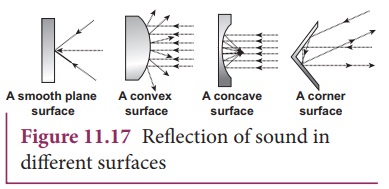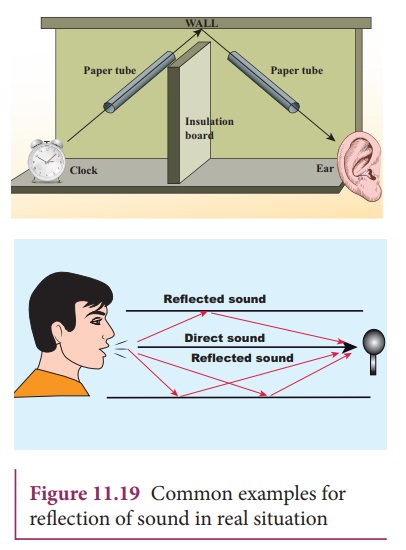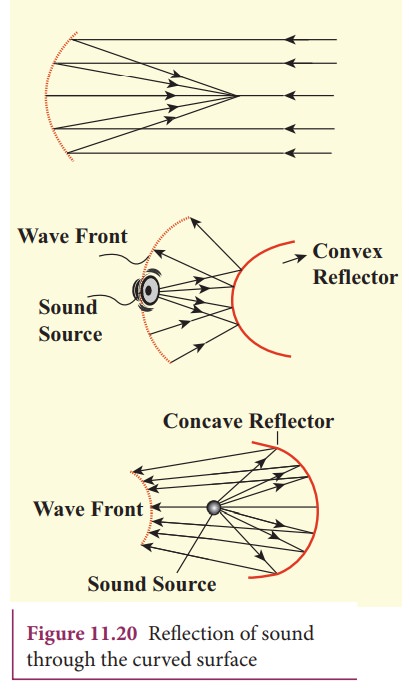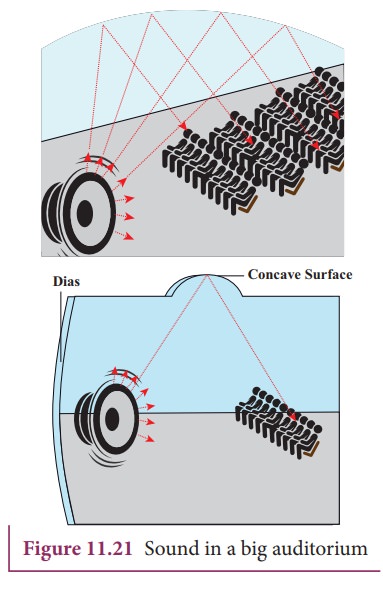Chapter: 11th Physics : UNIT 11 : Waves
Reflection of Sound Waves
REFLECTION
OF SOUND WAVES
When
sound wave passes from one medium to another medium, the following things can
happen
(a)
Reflection of sound: If the medium is highly dense (highly rigid),
the sound can be reflected completely (bounced back) to the original medium.
(b)
Refraction of sound: When the sound waves propagate from one medium
to another medium such that there can be some energy loss due to absorption by
the second medium.
In
this section, we will consider only the reflection of sound waves in a medium
when it experiences a harder surface. Similar to light, sound can also obey the
laws of reflection, which states that

(i) The angle of incidence of sound is equal to the angle of reflection.
(ii)
When the sound wave is reflected by a surface then the incident wave, reflected
wave and the normal at the point of incidence all lie in the same plane.
Similar
to reflection of light from a mirror, sound also reflects from a harder flat
surface, This is called as specular
reflection.
Specular
reflection is observed only when the wavelength of the source is smaller than
dimensions of the reflecting surface, as well as smaller than surface
irregularities.
Reflection of sound through the plane surface

When
the sound waves hit the plane wall, they bounce off in a manner similar to that
of light. Suppose a loudspeaker is kept at an angle with respect to a wall
(plane surface), then the waves coming from the source (assumed to be a point
source) can be treated as spherical wave fronts (say, compressions moving like
a spherical wave front). Therefore, the reflected wave front on the plane surface
is also spherical, such that its centre of curvature (which lies on the other
side of plane surface) can be treated as the image of the sound source (virtual
or imaginary loud speaker) which can be assumed to be at a position behind the
plane surface. These are shown in Figures 11.18, 11.19.


Reflection of sound through the curved surface
The
behaviour of sound is different when it is reflected from different
surfaces-convex or concave or plane. The sound reflected from a convex surface
is spread out and so it is easily attenuated and weakened. Whereas, if it is
reflected from the concave surface it will converge at a point and this can be
easily amplified. The parabolic reflector (curved reflector) which is used to
focus the sound precisely to a point is used in designing the parabolic mics
which are known as high directional microphones.

We
know that any surface (smooth or rough) can absorb sound. For example, the
sound produced in a big hall or auditorium or theatre is absorbed by the walls,
ceilings, floor, seats etc. To avoid such losses, a curved sound board (concave
board) is kept in front of the speaker, so that the board reflects the sound
waves of the speaker towards the audience. This method will minimize the
spreading of sound waves in all possible direction in that hall and also
enhances the uniform distribution of sound throughout the hall. That is why a
person sitting at any position in that hall can hear the sound without any
disturbance.
Applications of reflection of sound waves
(a) Stethoscope: It works on the principle of multiple reflections.

It
consists of three main parts:
(i) Chest piece
(ii) Ear piece
(iii) Rubber tube
(i) Chest piece: It consists of a small disc-shaped resonator (diaphragm)
which is very sensitive to sound and amplifies the sound it detects.
(ii) Ear piece: It is made up of metal tubes which are used to hear sounds
detected by the chest piece.
(iii) Rubber tube: This tube connects both chest piece and ear piece. It is
used to transmit the sound signal detected by the diaphragm, to the ear piece.
The sound of heart beats (or lungs) or any sound produced by internal organs
can be detected, and it reaches the ear piece through this tube by multiple
reflections.
(b) Echo: An echo is a repetition of sound produced by the reflection of sound
waves from a wall, mountain or other obstructing surfaces. The speed of sound
in air at 20°C is 344 m s-1.
If we shout at a wall which is at 344 m away, then the sound will take 1 second
to reach the wall. After reflection, the sound will take one more second to
reach us. Therefore, we hear the echo after two seconds.
Scientists have estimated that we
can hear two sounds properly if the time gap or time interval between each sound
is (1/10) th of a second (persistence of hearing) i.e., 0.1 s. Then,

The
minimum distance from a sound reflecting wall to hear an echo at 20°C is 17.2
meter.
(c) SONAR: SOund
NAvigation and Ranging. Sonar systems make use of reflections of sound waves in water to
locate the position or motion of an object. Similarly, dolphins and bats use
the sonar principle to find their way in the darkness.
(d) Reverberation: In a closed room the sound is repeatedly reflected from the
walls and it is even heard long after the sound source ceases to function. The
residual sound remaining in an enclosure and the phenomenon of multiple
reflections of sound is called reverberation. The duration for which the sound
persists is called reverberation time. It should be noted that the
reverberation time greatly affects the quality of sound heard in a hall.
Therefore, halls are constructed with some optimum reverberation time.
EXAMPLE 11.10
Suppose
a man stands at a distance from a cliff and claps his hands. He receives an
echo from the cliff after 4 second. Calculate the distance between the man and
the cliff. Assume the speed of sound to be 343 m s-1.
Solution
The
time taken by the sound to come back as echo is 2t = 4 ⇒ t
= 2 s
∴The distance is d = vt =(343
m s-1)(2 s) = 686 m.
Note: Classification
of sound waves: Sound waves can be
classified in three groups according to their range of frequencies:
(1) Infrasonic waves:
Sound waves having frequencies below 20 Hz are called infrasonic
waves. These waves are produced during earthquakes. Human beings cannot hear
these frequencies. Snakes can hear these frequencies.
(2) Audible waves:
Sound waves having frequencies between 20 Hz to 20,000 Hz
(20kHz) are called audible waves. Human beings can hear these frequencies.
(3) Ultrasonic waves:
Sound waves having frequencies greater than 20 kHz are known as
ultrasonic waves. Human beings cannot hear these frequencies. Bats can produce
and hear these frequencies.
Related Topics